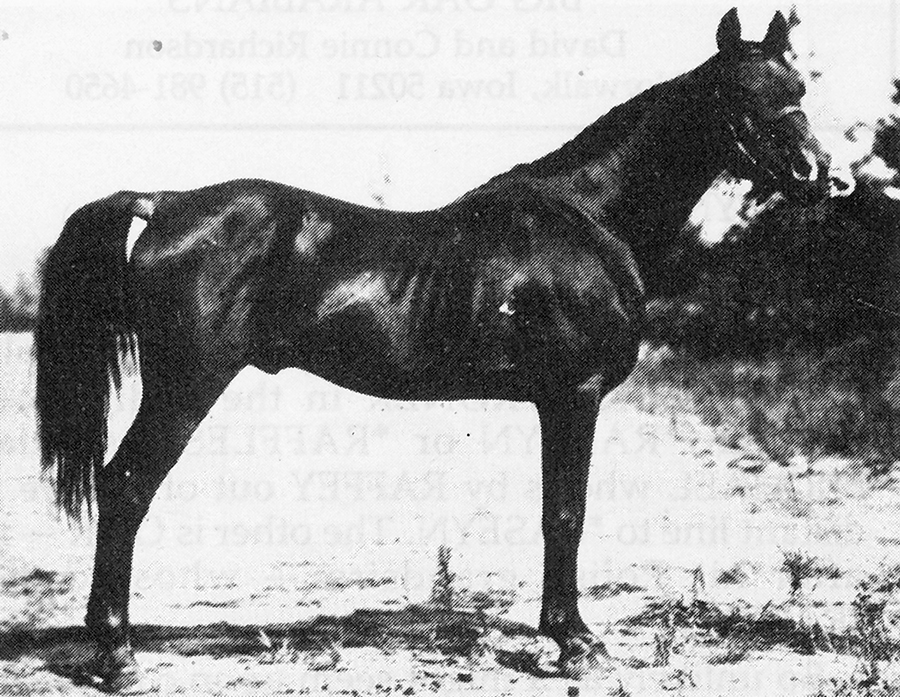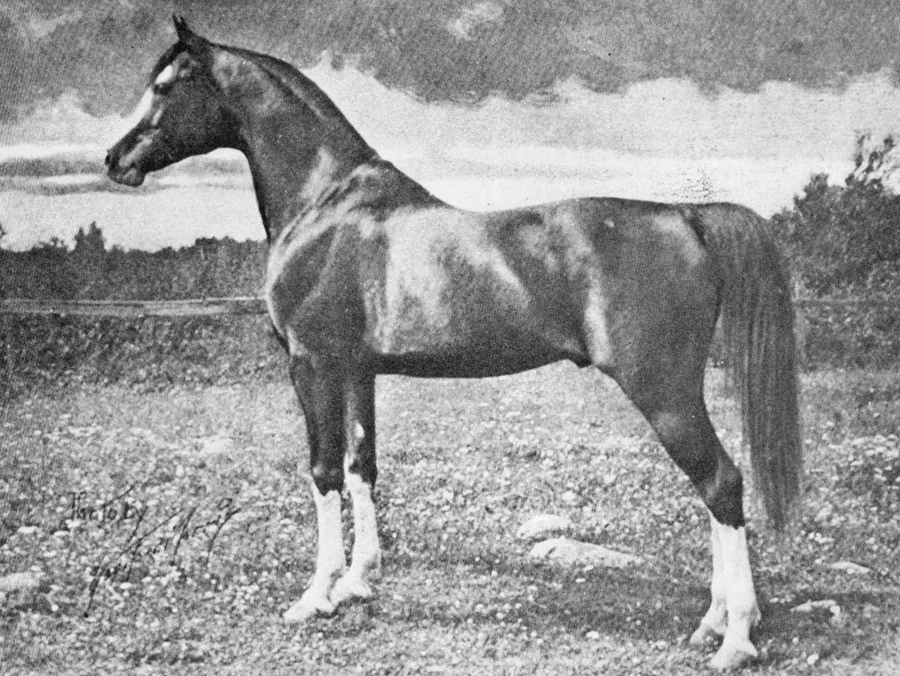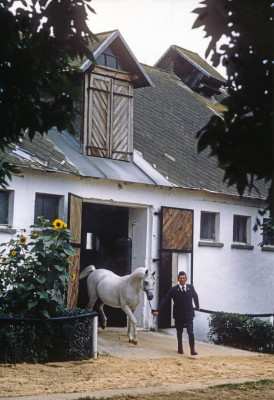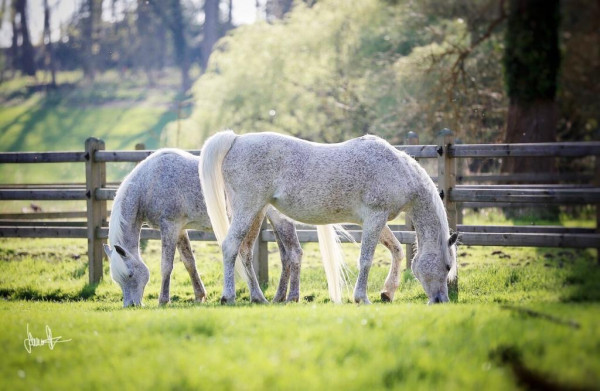The Founding Father
by Betty Finke
Who was the most influential Arabian stallion of all time?
The question regularly pops up on social media, and most often the first answer will be: Skowronek. It’s a reasonable answer. The influence of this 1909 Polish stallion (who, because of shifting borders, was born in the Ukraine) is vast and enduring. His many sons and daughters went to the USA, to Australia, to South Africa, to Russia, to Spain. Moreover, he stamped his foals with his own type and color and singlehandedly changed the look of the Arabian horse of his day. He was a one-horse revolution whose influence you can still see today.
 Mesaoud 1887 (Aziz II x Yemameh) at Crabbet.
Mesaoud 1887 (Aziz II x Yemameh) at Crabbet.
There’s a fly in the ointment, though. While you find Skowronek’s descendants everywhere in the world, you can just as easily find horses without him. Not one straight Egyptian Arabian descends from Skowronek. In other words, a popular and prominent section of the world’s Arabian horse population is completely Skowronek-free.
These days, you may also hear an alternative answer: Nazeer. And that’s a reasonable assumption, too. Nazeer’s sire line, originating in Egypt, has expanded to an extent where it completely dominates Arabian breeding, irrespective of nationality. He is the linear ancestor of Ali Jamaal, of WH Justice, of Marwan Al Shaqab, of Ansata Halim Shah. It is hard to find Arabians today that don’t trace to Nazeer, often multiple times, and it doesn’t matter if they’re straight Egyptian or anything else. So if you argue that Nazeer’s influence now eclipses that of Skowronek, you may have a point.
What everyone seems to forget is that one horse stands behind all of Skowronek’s descendants as well as all of Nazeer’s, and that horse is Mesaoud.
All of Skowronek’s get were out of Mesaoud granddaughters. Nazeer’s dam was double Mesaoud. So wherever you find Skowronek or Nazeer in a pedigree, you find Mesaoud as well. In fact, you’re unlikely to find an Arabian without Mesaoud in its pedigree anywhere today, short of straight Davenports, French racehorses, and actual desertbreds.
Arabian horse breeding has been connected across the globe right from the start, not just today.
Who was this horse whose bloodline permeates the breed like no other? And, more to the point: how did it happen, what did he contribute, and can his influence still be seen today?
Mesaoud was foaled on January 3, 1887, at the stud of Ali Pasha Sherif in Egypt. He stood 14.2 hh as a mature horse and was a bright chestnut with flashy markings: white stockings on all four legs, a blaze, and white spots beneath his jowls. The color was a legacy from his sire Aziz II, a chestnut with four white legs and a blaze.
Lady Anne Blunt was not too fond of this color, preferring bay. Yet she and her husband thought so highly of Aziz that in 1889, they purchased several of his get for their Crabbet Stud. One of them was Mesaoud. Writing in her journal on the day of the purchase, Lady Anne noted: “The pick is of course, the Seglawi Soudan son of Aziz, he is four white legged and high up to the knee but surprisingly handsome. For a defect there is a certain lightness of hock inherited from Aziz but nothing wrong.” (Journals and Correspondence, p. 197)
 Astraled 1900 (out of Queen of Sheba DB), Mesaoud’s most important son.
Astraled 1900 (out of Queen of Sheba DB), Mesaoud’s most important son.
Mesaoud’s dam was Yemameh, also known as Yemama, a daughter of the desertbred Zobeyni out of Bint Ghazieh, from the Saklawi Jedran of Ibn Sudan strain. This dam line still continues today in many countries and has been known to produce significant sires. They include Anter and Shahloul in Egypt, Jasir in Germany (Weil-Marbach), and such diverse horses as Gulastra, Al-Marah Radames, *Fadl, and Hallany Mistanny in the United States. More recent examples are the dressage-trained Babson stallion Serr Maariner and the World Champion and international sire *Carmargue. Some of these horses were long thought to belong to a different mare family, as there were several mares named Yemama in Egypt at the time and they got confused. It took the arrival of mtDNA-testing to set the matter straight.
Mesaoud initially remained at the Blunts’ place in Egypt. He was four years old when he came to England; not the first stallion to come to Crabbet Park, but certainly the one with the greatest impact. In the words of Wilfrid Blunt: “Mesaoud was by far the most important of our imported sires, and nearly all our best mares are descended from him. Indeed, he may be considered as the foundation line of our stud.” (Quoted by Peter Upton in The Arabian Horse).
In England, Mesaoud was shown a few times and won first prizes on several occasions. He was used at Crabbet Park from 1891 to 1903, siring foals every year; his largest crops were between 1897 and 1901. It’s a bit surprising to see that he sired more bays than chestnuts, but since the Blunts had many bay mares, it isn’t all that unlikely. The ratio of chestnuts increases during the later years, and Mesaoud himself was certainly responsible for the balance shifting from bay to chestnut at Crabbet.
What everyone seems to forget is that one horse stands behind all of Skowronek’s descendants as well as all of Nazeer’s, and that horse is Mesaoud.
He is also responsible for the proliferation of white markings that came to characterize Crabbet horses. This is often attributed to the desertbred foundation mare Rodania, who was also chestnut, but far more moderately marked than Mesaoud. She had the potential for producing high white, as shown by her flashy daughter *Rose of Sharon (by the bay Hadban), but it is doubtful she alone would have had the same effect. With both Rodania and Mesaoud in the mix, however, high white became something of a Crabbet trademark. It also helped that Lady Wentworth, unlike her parents, preferred chestnuts with white markings over moderately marked bays.
 Risala 1900 (out of Ridaa), Mesaoud’s most important daughter.
Risala 1900 (out of Ridaa), Mesaoud’s most important daughter.
Curiously enough, Mesaoud’s most important son *Astraled was bay/brown with no white at all, thanks to his dam Queen of Sheba. It is through *Astraled’s sons Rustem and Sotamm, as well as the Mesaoud granddaughter Bint Rissala, that Mesaoud’s bloodline got into straight Egyptian breeding. Sotamm sired Kazmeen, who was the maternal grandsire of Nazeer. Kazmeen carried an additional line to Mesaoud through his dam, who was by the Mesaoud son Narkise.
The Blunts retained 18 Mesaoud daughters as broodmares and used five of his sons at stud. By the time Skowronek arrived on the scene, all of Lady Wentworth’s broodmares were descended from Mesaoud, some even linebred to him. They were either his daughters, or the daughters of his sons *Astraled and Daoud, or out of his daughters. Let’s take a look at the most significant Skowronek get:
*Incoronata (1925) – out of Nisreen, double Mesaoud
Jalila (1922, exp. Spain) – out of Rasima, a Mesaoud granddaughter by Daoud
Naseem (1921), Nasifa (1924), and Naziri (1925) – out of Nasra, a Mesaoud granddaughter by Daoud
Naxina (1927) – out of Nessima, a Mesaoud granddaughter out of Narghileh
*Raffles (1926) – out of *Rifala, double Mesaoud
*Raseyn (1923) – out of Rayya, double Mesaoud
*Rifala (1922) and Reyna (1925, exp. Spain) – out of Rissla, double Mesaoud
*Raswan (1921) and *Rimini (1923) – out of Rim, Mesaoud granddaughter by *Astraled
*Rossana (1921) – out of Rose of Hind, Mesaoud granddaughter by Rejeb
So any time you see Skowronek in a pedigree, or Nazeer, Mesaoud is there as well, and he is there multiple times. Actually counting the number of times Mesaoud appears in a typical modern pedigree would require a lot of work and patience. Back in the 1970s, I did a count in the pedigree of a yearling filly and came up to 120, so it follows it has to be multiple times that today.
 Daoud 1899 (Mesaoud x Bint Nura), sire of Nasra.
Daoud 1899 (Mesaoud x Bint Nura), sire of Nasra.
Proving that he’s more than just a name in a pedigree, Mesaoud also created a certain look that came to be universally associated with Crabbet horses. Besides the chestnut color with white markings, this included strong hindquarters and sometimes (but by no means always) a shortish neck. This type could also appear elsewhere, even in Egypt. The popular 20th century sire Ibn Galal, bred at El Zahraa and used as a head sire at Hungary’s Bábolna stud and later exported to Germany, bore a striking resemblance to photographs of Mesaoud and passed this look on to many of his get.
The CMK horses in the USA, which are heavily Crabbet-based, owe more than a little to Mesaoud. The Mesaoud son *Abu Zeyd was an important early American foundation sire. *Astraled was also imported, as were two Mesaoud daughters, *Antika and *Rosetta. And, of course, every single Crabbet horse imported to the U.S., including several Skowronek sons and daughters, were Mesaoud descendants. The significant CMK sire Aurab and his son Ben Rabba both had that distinctive look. It may not be a type that wins halter shows, but it is certainly a type you see doing well in working and sports horse circles.
Mesaoud, along with all other Arabians owned by the Russian aristocrats, were lost in the Russian Revolution and the first world war.
After doing his duty at Crabbet for twelve years, Mesaoud was sold to Russia in 1903. At that point, the Blunts could afford to part with him, because most of their mares as well as their stallions were his descendants. He had certainly increased in value by then. The Blunts had originally bought him for 60 pounds, and the Russian buyer paid 240 guineas! That’s a tidy profit.
 *Abu Zeyd 1904 (Mesaoud x Rose Diamond), U.S. foundation sire.
*Abu Zeyd 1904 (Mesaoud x Rose Diamond), U.S. foundation sire.
Sadly, we will never learn what impact Mesaoud might have had in Russia. He, along with all other Arabians owned by the Russian aristocrats, were lost in the Russian Revolution and the first world war. His influence still permeates Russian bloodlines, though, because when the Tersk Stud was founded, the Russians wasted no time importing a bunch of horses from Crabbet Park – all of them Mesaoud descendants, of course. Many of the Russian horses that were so popular during the 1980s and 1990s unmistakably bore his stamp, foremost among them U.S. National Champion *Muscat.
 Mesaoud 1887 (Aziz II x Yemameh) at Crabbet.
Mesaoud 1887 (Aziz II x Yemameh) at Crabbet.
In 2022, Mesaoud unexpectedly made headlines again. Examining original Arabic documents from the time of Abbas Pasha, researcher Edouard Al-Dahdah discovered that Mesaoud’s paternal grandsire Harqan was not (as has been thought) by Zobeyni, but by another horse named Aziz, who was sired by Gadir. These findings were published in the book “The Arabian Horses of Abbas Pasha: New Discoveries: the 1860 Abbas Pasha Sale List and Other Original Documents.” This is a significant discovery, as Gadir was one of Abbas Pasha’s most celebrated sires and his line was assumed to be lost. At the 1860 Abbas Pasha dispersal sale, Gadir was sold to the Royal Weil Stud of King Wilhelm I of Württemberg. Several decades later, Weil imported another stallion from Egypt, the very influential Jasir (Mabrouk x Negma). He became the first Arabian chief sire at Marbach State Stud, which took over the Weil horses in 1932. Coincidentally (since no one was aware of it at the time) Jasir was not only from the same dam line as Mesaoud: his grandam Bint Yamama was actually Mesaoud’s half-sister.
Which shows, among other things, that Arabian horse breeding has been connected across the globe right from the start, not just today.

























